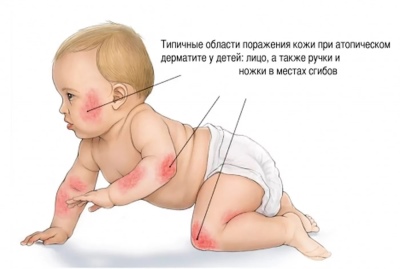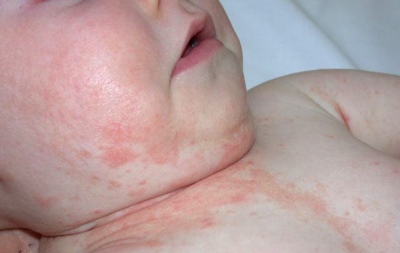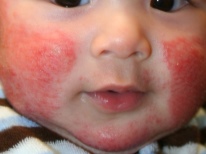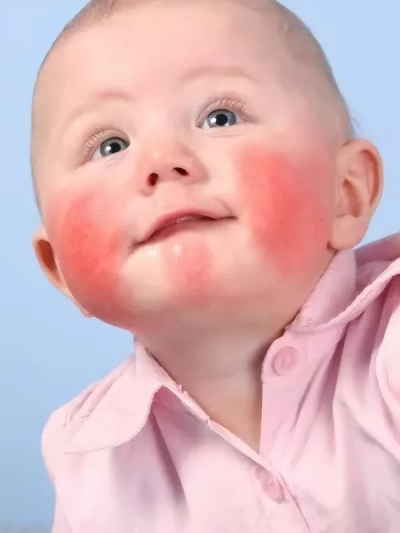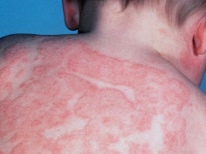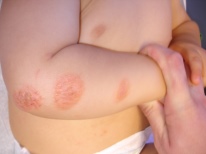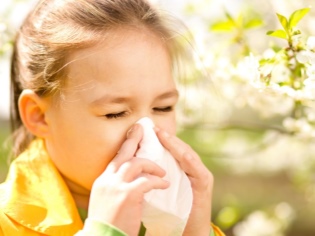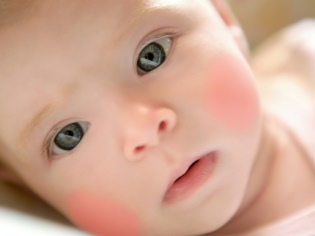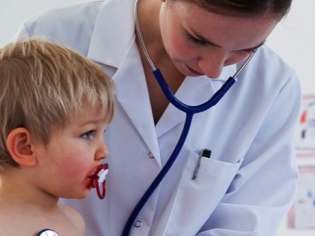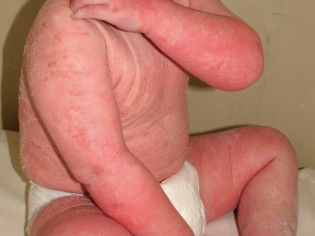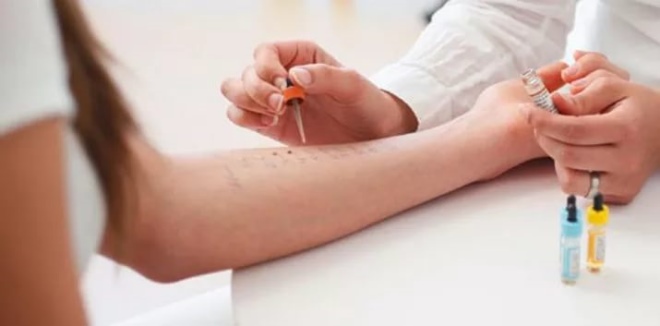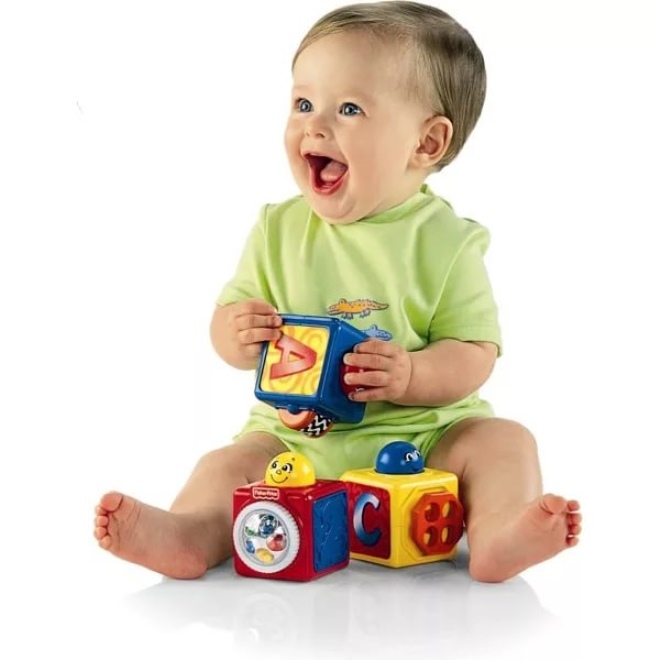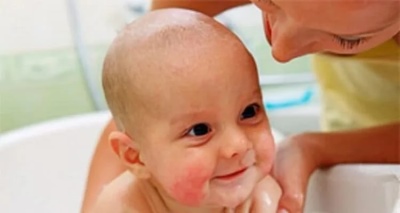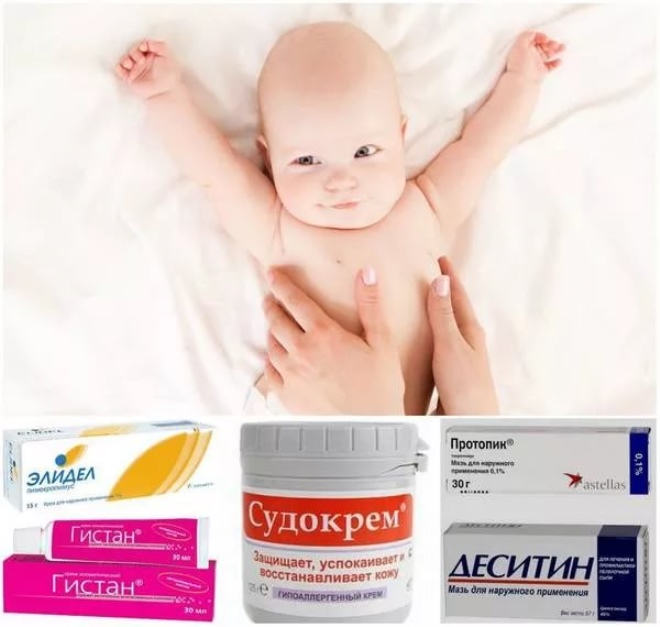Allergic dermatitis in children
Allergy Parents usually don’t be surprised at the child’s skin, since nine out of ten babies have spots and an incomprehensible rash from time to time. Adults often do not pay enough attention to such symptoms, habitually blaming the skin manifestations on the fact that the child “ate something” or on a pottery. In fact, allergic dermatitis - the disease is quite serious and without proper response can have quite tangible consequences.
What it is
Allergic dermatitis is a skin disease that occurs when it comes into contact with an allergen. It is important to distinguish this disease from another child’s typical skin disease - atopic dermatitis. An atopic reaction occurs when a child is genetically predisposed to allergies, and the organism usually responds to a specific protein, immunoglobulin E (IgE), with an inadequate response. The reaction takes place at the cellular level. That is why it is so difficult to determine which allergen actually caused atopic dermatitis.
Allergic dermatitis is not genetically determined. Yes, and the skin reaction itself is a consequence of the immune response to other protein antigens. It is a delayed type reaction. That is why allergic dermatitis is often called contact, because the disease does not develop without direct contact with the irritant.
Contact dermatitis itself in children can be irritating and allergic. In the first case, there is talk of local irritation, which quickly disappears when contact is terminated, and in the second case, a more extensive body reaction to the allergen is understood.
Thus, the main difference lies in the fact that atopic dermatitis in a child prone to it may worsen even with overheating, hypothermia, or overeating - factors that do not have particular allergenic value. But allergic is always manifested in the presence of a specific allergen - in the air, in food, in objects surrounding the baby.
A few decades ago, allergic dermatitis was recorded infrequently, according to which the World Health Organization did not even have separate statistics. But lately, doctors have noted with regret that the number of children, and even adults suffering from this disease, is growing every year. Today, about 70% of children suffer from this or that type of skin allergy. Most of the diagnoses are in atopic dermatitis - about 20%; in allergic dermatitis, a share of about 11% is released.
But the real picture is even worse, because not all parents seek the help of a doctor, and, therefore, do not fall into the statistics. Among all people on the planet who suffer from allergies, approximately 45% are children. Their immunity is not ready to accept our reality, with all its environmental difficulties and scientific progress, genetic engineering in food production and a huge number of cars for every child's head per capita.
It is the environmental imbalance that scientists believe is the main reason for the increase in the number of children with allergies. Allergic dermatitis has no age range. Everything is subject to him - from infants to pensioners.But due to the tenderness and vulnerability of children's skin in babies, the disease still occurs more often.
How does inflammation occur?
The mechanism of the occurrence of a postponed allergic reaction is rather difficult to explain, besides, it is not yet fully understood. But on the basis of the data currently available, we can safely say that inflammation "organizes" the immune system itself. This behavior is understandable: the molecules of allergens are very small in size, and when such a substance first enters the body, vigilant and non-sleeping immune lymphocyte cells are simply not able to “notice” that outsiders have entered.
Microscopic allergens, in the meantime, are associated with certain proteins, as well as viruses, bacteria, and as a result they noticeably “grow up”, acquire solid dimensions. It is finally noticed by the immune cells, the “allergen + protein” construction is destroyed, but the intruder is remembered for a long time. When the child next time comes into contact with the same allergen, the lymphocytes, without wasting time, begin to “shoot a cannon at the sparrows,” and the baby’s skin becomes covered by what comes out of such a struggle - an inflammatory rash.
For information on how allergic dermatitis occurs, its symptoms and how to deal with it, see the next video.
Causes
Childhood allergies are sometimes called retribution for the unreasonableness of humanity. Bad ecology, poor-quality food, an abundance of all kinds of medicines that are sold freely, without a prescription, a lot of different cosmetics for a newborn instead of the usual and safe baby soap - all these factors contribute to the development of allergic dermatitis in children.
Unsafe, this world is starting to be even for those babies who are breastfed, because they can get allergens along with their mother's milk, because mother eats products from the supermarket.
Allergens surround the child everywhere from the first minutes of his independent life outside of his mother's belly. However, in some children they do not cause a violent reaction, while others color them with a bright rash. So far no one can name the exact mechanisms of such a reaction, but doctors call the state of immunity of a particular child at a specific period of life and the amount of allergen as probable causes.
The most common allergens are:
- medicines;
- cosmetics and perfumes;
- paints and household chemicals;
- metals and polymers, as well as synthetics.
Plays a role and psychological state of the child. So, children from dysfunctional, from the point of view of interpersonal relations of families, to whom physical punishment measures are applied, where they are often scandalous, are more susceptible to an allergic reaction. The severity of the symptoms is also influenced by the propensity for sweating. Sweat increases skin irritation and increases the area of the affected areas. Toxic-allergic dermatitis may occur when inhalation of some aggressive substances that cause a violent immune response in the body. These include pollen, chlorine vapors, house dust, etc.
Danger
The main danger of atopic dermatitis is that it can become chronic. A rash itself can become complicated at the local level if such microbial as streptococcus enters the areas with formed eczema, which is surprising in its harmfulness and persistence. Then the concomitant disease develops - streptoderma.
In children with severe forms of toxic-allergic dermatitis, disorders of the kidneys, heart, liver and lungs can occur.
Symptoms and signs
Despite the limited impact - the child touched something that could cause an inadequate reaction, breathed in allergens with vapors of household chemicals or mum's spirits, sensitization develops a common one. In this case, it is quite difficult to establish what went wrong and when.With allergic dermatitis, as mentioned above, the reaction is slow, which means that it can appear only a few days after contact with the allergen. At the same time, you need to be able to remember that the child touched where he was, what he breathed and what he ate. Answer all these questions with great accuracy, in principle, impossible.
In allergic dermatitis, the main symptom is a rash. In general, the skin is quite tense, especially at the point of contact with the allergen, when it comes to contact form. The lesion looks reddened and slightly swollen. In the contactless form, a rash can appear on the most delicate parts of the body - on the face, especially on the cheeks, on the head in the scalp, as well as on the arms and legs, especially in the skin folds on the folds.
A rash may look like small pink dots, as well as quite often bubbles appear that quickly burst, leaving a moist, gradually drying crust. All elements of the rash appear at the same time, they have no clear boundaries.
When the disease is neglected, if the contact with the allergen is not interrupted for a long time, despite the violent reaction of the body, the rash can be transformed into eczema with severe sensitization.
An older child can quite clearly complain of itching. A crumb before the year will constantly stretch his arms to the places of defeat, try to scratch them. A newborn baby will behave restlessly, since severe itching can disrupt his sleep, appetite. With severe allergic dermatitis and a large affected area, the child may have a fever of subfebrile values - 37.5 0 37.9 degrees.
Diagnostics
If you experience a fuzzy blistering rash, be sure to call a doctor. First, in order to exclude one of the most dangerous infectious diseases, which are also accompanied by a blistering rash (herpes virus infections, for example). Secondly, by the nature of the rash, an experienced doctor is quite able to understand how strong the allergic reaction is and immediately prescribe something that alleviates the child’s condition, saving him from severe itching and burning.
The second stage of the survey should be a visit to an allergist or a dermatologist. With the help of special application tests, these doctors will be able to determine what exactly this skin reaction appeared to. Tests are small paper strips with a sticky base, they are attached to the skin of a child, and after a day or two, they evaluate the result. If the skin under the strip reddened, then allergy occurs precisely to this allergen. The disadvantages of the tests are that the child, although it is attached to the test strips on the back, is very mobile, it can unstick them ahead of time. Only the most common allergens are included in the strips themselves, and it’s not at all the fact that the child will have a reaction to them, because its own rash could cause an allergen that is not listed.
The most informative is the blood test for immunoglobulins. If their level is elevated, then this indicates an allergic disease, and the rise of certain immunoglobulins compared with the level of the others, will prompt the doctor about possible ways of searching for a specific "culprit" of a skin rash.
Sometimes doctors advise scarification tests for small patients. They are carried out under the supervision of a doctor who applies small scratches on the skin of the forearm with a scalpel and causes allergens. For each such scratch - one sample. Then the reaction or the absence of the reaction is evaluated
For children with severe allergic dermatitis, additional research may be indicated, which will include:
- feces on the eggs of the worm and a blood test for traces of parasites;
- thyroid examination and blood test for hormones.
All children with allergic dermatitis, without exception, are shown to pass a general and biochemical blood test.
Treatment
The treatment is based on the elimination of the allergen that caused an inadequate immune response. If you do it in time, you can do without the use of medicines, since the inflammatory process will not increase. But, despite the numerous diagnostic methods and the level of development of modern medicine, it is quite difficult to find the true "culprit" of the disease. In this case, parents are given general recommendations that are aimed at preventing contacts with the maximum number of allergens.
Nutrition
First of all, it is recommended to review the diet of the child. Need special hypoallergenic diet. Nuts, citrus fruits, red berries, pickled foods and all spices, honey, chicken eggs, factory sweets, yeast dough and pastries should be excluded from the menu. Children under one and a half years to minimize the use of whole cow's milk, goat's milk and products from it. It is better to give preference to hypoallergenic infant formula. For children up to 6 months they must be fully adapted, for children from six months - partially adapted.
If a baby with allergies feeds on breast milk, the mother should review her diet and eliminate the above products, as well as onions, garlic, and all foods with food dyes.
clothing
As already mentioned, the sweating child is more prone to the painful forms of severe allergic dermatitis. Therefore, parents should strip the baby to reasonable limits, make sure that he does not sweat while playing at home and on walks. If it is winter and you don’t sweat in a jacket and hat while playing active games in the air, after each walk you should rinse the child with water from the shower, without soap, and immediately change into clean, dry clothes. The clothes themselves should be from natural fabrics, all synthetics should be hidden away. Optimally, if things are of the most ordinary white color, without textile dyes. The same goes for bed linen.
home furnishings
From the house immediately after returning from the doctor, regardless of whether the cause of the allergy was found, everything that may be allergenic should be removed. In the standard apartment of an ordinary Russian family such things are abundant. These are carpets, large soft toys, which furnish the entire children's room, lying in piles of books. Books should be hidden in the closet and closed away, and carpets and toys should be brought to the garage or on the balcony as far as possible, since they are the main accumulators of allergenic house dust.
All detergents, all bottles and household chemicals should be removed from the reach area.
Cleaning in the house where a child with allergic dermatitis lives should be carried out without the use of chemistry in general; in extreme cases, use its soft options that do not contain chlorine.
Children's clothes and clothes, as well as things of everyone who takes the child in his arms and in contact with his skin, should be washed exclusively with hypoallergenic baby powder and be sure to rinse off. In the nursery, you need to create the right temperature conditions - at a temperature of about 20 degrees and no more the child will not sweat, and with a relative humidity of 50 to 70% of his skin will not dry up, and the inflammation will pass quickly.
Cosmetics
It is necessary to bathe a child with atopic dermatitis daily, but baby soap should be used no more than once a week so as not to overdry an already derma injured by the inflammatory process. Foams, shower gels with pleasant fruit aromas should be discarded, giving preference to the simplest and most inexpensive children's soap without fragrances and dyes.
Medicines
An ointment or cream with anti-inflammatory action is usually added to the above complex of measures for children suffering from itching on the affected skin areas with allergic dermatitis. Commonly used corticosteroids, such as "Elokom», «Advantan"," Celestoderm. " If the decision is made not to use hormonal ointments, since dermatitis is not so strongly pronounced, then the non-hormonal “Fenistil”, “Bepanten, La Cree.
In severe allergic reactions of the toxic form, a child may be prescribed antihistamine medications by age.
In pediatrics, they most often prefer to treat "Loratadine"Or" Suprastinom ". Simultaneously with them, children definitely need to take calcium supplements. Sometimes doctors recommend a mild infant sedative, if the itching of the skin prevents the child from falling asleep even after applying ointments. Usually such a condition, if all recommendations are followed, passes in a few days.
Treatment of folk remedies
Specialists do not recommend treating allergic dermatitis with folk remedies at home. In many ways, because most of the recipes of alternative medicine are based on the properties of medicinal plants. Namely, it is not necessary to contact a child with an acute stage of dermatitis, because herbs and flowers are potentially dangerous allergens. Any application inside or outwardly of herbal remedies or decoction must be coordinated with the doctor, otherwise the condition of the child may deteriorate significantly.
Interesting Facts
- Frequently watching TV by a child (more than 2 hours a day) increases the risk of allergic reactions.
- If the child since birth communicates with pets and the cat is not at all barred from entering the room with the baby or even lying next to it, then, according to the observations of experts, the risk of developing an allergy for such a child is minimal.
- Some vitamins can reduce allergyIn particular, group B, vitamins C and E. This was noticed by doctors who recommended vitamin preparations to their patients with chronic allergic diseases.
- For a child with atopic dermatitis normal and restful sleep is very important, because it is in a dream that immunity corrects its “mistakes”, the defense system is being debugged and allergies are as a result managed to be overcome faster.

